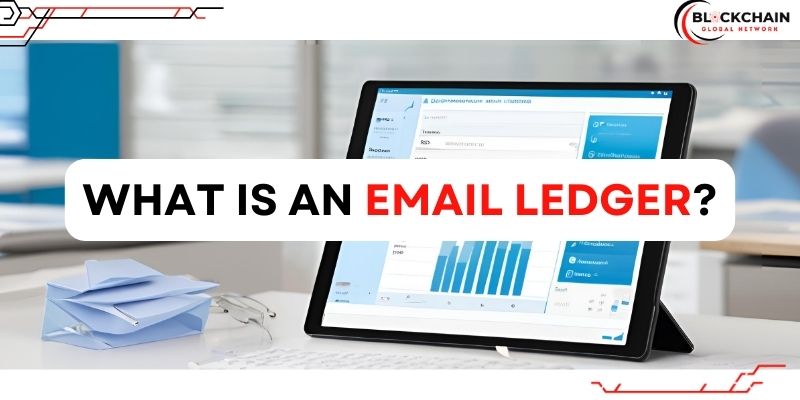Understanding the difference between From vs Reply To in Email Ledger is crucial for managing email communication effectively. These fields not only identify the sender and the recipient of replies but also impact how information is tracked and verified in the email ledger, especially in business and blockchain environments.
What is an Email Ledger?
An email ledger is a digital record system that stores and tracks email communication. In its simplest form, it is an electronic version of a traditional ledger, but it specifically tracks the flow of email messages. This system ensures that email transactions, whether in a business or blockchain context, are securely documented and easily traceable.
An email ledger works by recording details such as sender, recipient, timestamp, and the content of the message. It may also record additional metadata like attachments, read receipts, or status updates (e.g., delivered or bounced). In the case of blockchain email ledgers, this information is stored on a decentralized network, providing transparency and immutability, which prevents tampering and ensures the integrity of the data.
Why is it important? Email ledgers are vital because they provide transparency and ensure the accuracy of email communication records. With businesses increasingly relying on email for official communication, having a tamper-proof, auditable record is crucial for compliance, dispute resolution, and customer support. Additionally, in the world of blockchain, email ledgers allow for secure, verifiable, and traceable communication, which is crucial for smart contract execution, legal purposes, and financial transactions.
- Transparency: Clear, accessible records of all email communications.
- Immutability: Once an email transaction is recorded, it cannot be altered or erased, ensuring its authenticity.
- Auditability: A comprehensive history of email exchanges, useful for monitoring, compliance, and legal purposes.
- Security: Provides a secure method for tracking sensitive communications, especially in blockchain and enterprise settings.
The “From” Field in an Email Ledger
Definition and Function
The “From” field in an email is crucial because it identifies the sender of the message. It specifies who is responsible for the communication, whether it is an individual or an organization. This field typically contains an email address, along with the sender’s name (e.g., John Doe johndoe@example.com).
Role in Email Ledger
In the context of an email ledger, the “From” field serves as the starting point for recording email transactions. It helps establish the origin of the communication and ensures that each email’s source is verifiable. By tracking the “From” field, businesses and blockchain networks can establish the authenticity of the message, verify its origin, and prevent fraud or impersonation. This is especially important in environments where the integrity of communication is paramount, such as legal and financial transactions.
Example in Email Transactions
Consider an email from a customer service department:
From: support@company.com
Subject: Your Order Update
Here, the “From” field identifies the support team as the sender, which is important for confirming the legitimacy of the communication and resolving any customer queries effectively.
The “Reply To” Field in an Email Ledger
Definition and Function
The “Reply To” field in an email specifies an alternative email address to which the recipient should respond. This is often used when the sender does not want replies to be directed to the same address used in the “From” field. For example, a marketing department may send an email from a generic address like marketing@company.com but use a personal address, john.doe@company.com, in the “Reply To” field for replies.
Role in Email Ledger
The “Reply To” field plays a crucial role in ensuring that responses are directed to the correct person or department. In an email ledger, tracking the “Reply To” field ensures that communication continues smoothly, and the correct individual or team receives the follow-up information. This is especially important in systems where different teams manage different aspects of communication, such as sales, support, or legal departments.
Example in Email Transactions
Suppose a company sends a promotional email with the following details:
From: marketing@company.com
Reply To: john.doe@company.com
In this case, even though the email is sent from a marketing address, responses will be directed to the personal inbox of the marketing manager, John Doe.
Differences Between From vs Reply To in Email Ledger
Comparison of Functions
While both the “From” and “Reply To” fields indicate who is associated with the email, they serve different purposes. The “From” field identifies the initial sender, ensuring that the message’s origin is clearly stated. In contrast, the “Reply To” field directs replies to a different address, which might be more relevant for customer service or administrative responses.
- “From” Field: Establishes the email’s sender and its legitimacy.
- “Reply To” Field: Ensures responses are routed to the appropriate person or department.

Impact on Email Tracking and Management
In an email ledger, understanding the difference between the “From” and “Reply To” fields is essential for accurate tracking and management of communication history. For example, if a business needs to audit email responses, they must track both fields to differentiate between initial contacts and follow-up communications. The ledger ensures that both actions are recorded correctly, creating a clear trail for review.
Benefits in Real-World Applications
- Email Marketing: The “From” field helps marketers track the identity of the campaign, while the “Reply To” field ensures that responses are routed to the correct team for follow-up.
- CRM Systems: Properly managing both fields allows businesses to integrate email communications into CRM systems, ensuring that customer interactions are handled efficiently.
- Blockchain Transactions: In blockchain, these fields can be used to verify the integrity and direction of communication, crucial for secure digital transactions and smart contracts.
Practical Applications of “From” and “Reply To” in Email Ledger
Applications in Business
In an enterprise environment, both the “From” and “Reply To” fields are vital for managing communication workflows. For example:
- Customer Support: A customer service team may use a “From” field (e.g., support@company.com) but configure a “Reply To” field pointing to a specific support agent’s address to ensure direct communication.
- Internal Communication: Teams within an organization often use a shared “From” address for official emails but route responses to individual members through the “Reply To” field.
Applications in Blockchain and Smart Contracts
In the blockchain environment, email ledgers are used to track communication related to digital transactions. The “From” and “Reply To” fields can be part of an immutable record that verifies the authenticity of communications between parties involved in a smart contract. This is crucial for ensuring the accuracy and accountability of blockchain-based email transactions, where miscommunication can lead to costly errors.
By leveraging email ledgers in conjunction with blockchain, businesses can ensure that email communications are as secure and traceable as the transactions themselves.Curious about secure email tracking? What are Ledgers Legit Emails will explains how email ledgers ensure authenticity and transparency in email communication. Learn how this tool is essential for business and blockchain security!
Visit Blockchain Global Network to stay updated with news and in-depth knowledge on blockchain technology.


RELATED POSTS
Who has Andrew Tate’s Crypto Wallet?
Who has Andrew Tate’s Crypto...
DuckChain Airdrop: Great opportunity to get free Tokens
In the context of rapid...
DePIN Alliance Airdrop – Extremely HOT VTIS 2024 Event
DePIN Alliance Airdrop – Highlight...
What is the Cryptocurrency Market? How Transactions Work on the Blockchain
Curious about what is the...
Kroma Airdrop Season 2 – Opportunity to Earn KRO and Explore Web3
Kroma Airdrop Season 2 is...
What is Optimism? A promising Layer 2 solution for Ethereum
Ethereum is facing scalability challenges,...
Pi Network Officially Lists on OKX Exchange on February 20: New Opportunities for Pi Holders?
Pi Network Officially Lists on...
Explore Top DePin AI Projects
Exploring the leading DePin AI...
BrainGames Airdrop: How to earn LEARN Tokens
BrainGames Airdrop is a unique...
Blockchain for Financial Services: Transforming Global Finance
The financial sector is undergoing...
U2U Network was Honored by Asia Business Outlook – Shaping the Future of Blockchain
U2U Network was honored by...
Acki Nacki Airdrop: A detailed guide on how to participate
In the rapidly evolving world...
How blockchain is revolutionizing the healthcare industry
The healthcare industry is grappling...
Network3 Airdrop – Potential Profits in the Future
Network3 Airdrop offers potential profit...
Crypto Crashing and 3 important investment implications
Crypto Crashing has shaken the...
Pencils Protocol: Optimizing DeFi yields on Scroll
In the vast landscape of...